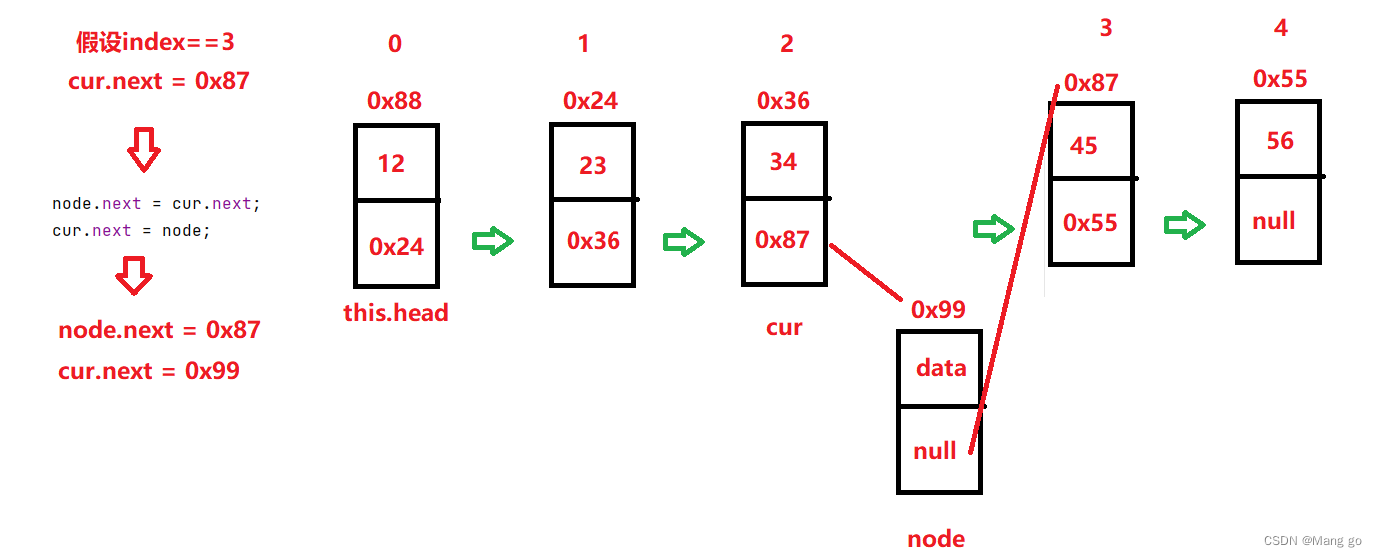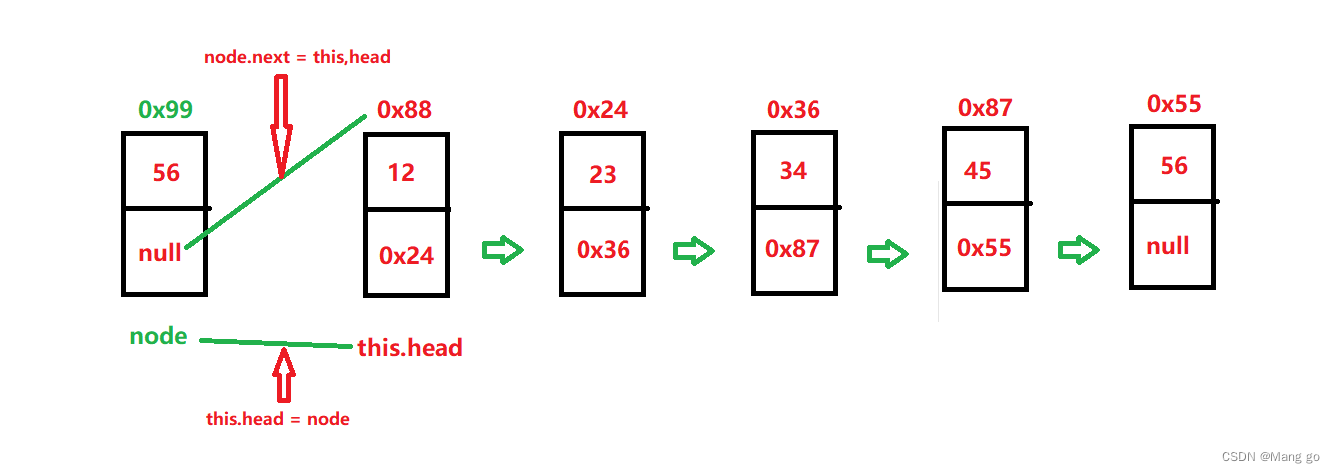-
【数据结构】LinkedList与链表
1. ArrayList的缺陷
上节课已经熟悉了ArrayList的使用,并且进行了简单模拟实现。通过源码知道,ArrayList底层使用数组来存储元素:
public class ArrayList<E> extends AbstractList<E> implements List<E>, RandomAccess, Cloneable, java.io.Serializable { // ... // 默认容量是10 private static final int DEFAULT_CAPACITY = 10; //... // 数组:用来存储元素 transient Object[] elementData; // non-private to simplify nested class access // 有效元素个数 private int size; public ArrayList(int initialCapacity) { if (initialCapacity > 0) { this.elementData = new Object[initialCapacity]; } else if (initialCapacity == 0) { this.elementData = EMPTY_ELEMENTDATA; } else { throw new IllegalArgumentException("Illegal Capacity: "+ initialCapacity); } } // }- 1
- 2
- 3
- 4
- 5
- 6
- 7
- 8
- 9
- 10
- 11
- 12
- 13
- 14
- 15
- 16
- 17
- 18
- 19
- 20
- 21
- 22
- 23
由于其底层是一段连续空间,当在ArrayList任意位置插入或者删除元素时,就需要将后序元素整体往前或者往后搬移,时间复杂度为O(n),效率比较低,因此ArrayList不适合做任意位置插入和删除比较多的场景。因此:java集合中又引入了LinkedList,即链表结构。
2. 链表
2.1 链表的概念及结构
链表是一种物理存储结构上非连续存储结构,数据元素的逻辑顺序是通过链表中的引用链接次序实现的 。

实际中链表的结构非常多样,以下情况组合起来就有8种链表结构:- 单向或者双向

- 带头或者不带头

- 循环或者非循环

虽然有这么多的链表的结构,但是我们重点掌握两种:
无头单向非循环链表:结构简单,一般不会单独用来存数据。实际中更多是作为其他数据结构的子结构,如哈希桶、图的邻接表等等。另外这种结构在笔试面试中出现很多

无头双向链表:在Java的集合框架库中LinkedList底层实现就是无头双向循环链表
2.2 链表的实现
1.链表的功能
package mysingleList; public interface IList { void addFirst(int data); //尾插法 void addLast(int data); //任意位置插入,第一个数据节点为0号下标 void addIndex(int index,int data); //查找是否包含关键字key是否在单链表当中 boolean contains(int key); //删除第一次出现关键字为key的节点 void remove(int key); //删除所有值为key的节点 void removeAllKey(int key); //得到单链表的长度 int size(); void clear(); void display(); }- 1
- 2
- 3
- 4
- 5
- 6
- 7
- 8
- 9
- 10
- 11
- 12
- 13
- 14
- 15
- 16
- 17
- 18
- 19
- 20
2.初始化链表
public class MySingleList implements IList{ static class ListNode{ public int val; public ListNode next; public ListNode(int val){ this.val = val; } } public ListNode head; public void createList(){ ListNode node1 = new ListNode(12); ListNode node2 = new ListNode(23); ListNode node3 = new ListNode(34); ListNode node4 = new ListNode(45); ListNode node5 = new ListNode(56); node1.next = node2; node2.next = node3; node3.next = node4; node4.next = node5; this.head = node1; }- 1
- 2
- 3
- 4
- 5
- 6
- 7
- 8
- 9
- 10
- 11
- 12
- 13
- 14
- 15
- 16
- 17
- 18
- 19
- 20
- 21
- 22
- 23
- 24
- 25
开辟了内存空间

使每个node的next域指向下一个节点的地址,连接成链表
head指向第一个节点的地址

3.实现功能接口
3.1头插添加元素
public void addFirst(int data) { ListNode node = new ListNode(data); if(this.head == null){ this.head = node; } else { node.next = this.head; this.head = node; } }- 1
- 2
- 3
- 4
- 5
- 6
- 7
- 8
- 9
- 10
对 node.next = this.head;
this.head = node;
进行解释,node的next域指向下一个节点的地址
head继续为头节点
3.2尾插法添加新元素
public void addLast(int data) { ListNode node = new ListNode(data); ListNode cur = head; if (this.head == null){ this.head = node; } else { while(cur.next != null){ cur = cur.next; } cur.next = node; } }- 1
- 2
- 3
- 4
- 5
- 6
- 7
- 8
- 9
- 10
- 11
- 12
- 13
找到最后一个元素cur,cur的next指向要插入元素的地址

3.3找到下标的前驱节点
private ListNode searchPrev(int index){ ListNode cur = this.head; int count = 0; while(count != index-1){ cur = cur.next; count++; } return cur; }- 1
- 2
- 3
- 4
- 5
- 6
- 7
- 8
- 9
3.4指定位置插入元素
public void addIndex(int index, int data) { //判断index的位置是否合法 if(index < 0 || index >size()){ return; } //插入到第一个节点位置 if(index == 0){ addFirst(data); } //插入到最后一个节点的位置 if (index == size()){ addLast(data); } //中间位置 else { ListNode node = new ListNode(data); ListNode cur = searchPrev(index); node.next = cur.next; cur.next = node; } }- 1
- 2
- 3
- 4
- 5
- 6
- 7
- 8
- 9
- 10
- 11
- 12
- 13
- 14
- 15
- 16
- 17
- 18
- 19
- 20
- 21

3.5指定元素是否存在
public boolean contains(int key) { ListNode cur = this.head; while(cur != null){ if(cur.val == key){ return true; } } return false; }- 1
- 2
- 3
- 4
- 5
- 6
- 7
- 8
- 9
- 10
- 11
遍历一遍链表寻找是否有key元素
3.6找到指定元素的前驱节点
private ListNode findPrev(int key){ ListNode cur = this.head; while(cur.next != null){ if (cur.next.val == key){ return cur; } cur = cur.next; } return null; }- 1
- 2
- 3
- 4
- 5
- 6
- 7
- 8
- 9
- 10
3.7删除指定节点
public void remove(int key) { if (this.head == null){ System.out.println("没有节点,无法删除"); return; } //指定元素在头节点 if (this.head.val == key){ this.head = this.head.next; } else { ListNode cur = findPrev(key); //没有找到指定元素 if (cur == null){ System.out.println("没有找到要删除的节点"); return; } //找到了指定元素 ListNode del = cur.next; cur.next = del.next; } }- 1
- 2
- 3
- 4
- 5
- 6
- 7
- 8
- 9
- 10
- 11
- 12
- 13
- 14
- 15
- 16
- 17
- 18
- 19
- 20
- 21
- 22
- 23

3.8删除所有元素为key的节点
public void removeAllKey(int key) { if(this.head == null){ return; } ListNode prev = this.head; ListNode cur = this.head.next; while(cur != null){ if(cur.val == key){ prev.next = cur.next; cur = cur.next; } else { prev = cur; cur = cur.next; } } //删除的节点为头节点 if(this.head.val == key){ this.head = this.head.next; } }- 1
- 2
- 3
- 4
- 5
- 6
- 7
- 8
- 9
- 10
- 11
- 12
- 13
- 14
- 15
- 16
- 17
- 18
- 19
- 20
- 21
- 22
3.9链表的长度
public int size() { ListNode cur = this.head; int count = 0; while(cur != null) { count++; cur = cur.next; } return count; }- 1
- 2
- 3
- 4
- 5
- 6
- 7
- 8
- 9
3.9清空链表
public void clear() { ListNode cur = this.head; while(cur != null){ ListNode curNext = cur.next; cur.next = null; cur = curNext; } head = null; }- 1
- 2
- 3
- 4
- 5
- 6
- 7
- 8
- 9
- 10
完整代码
package mysingleList; public class MySingleList implements IList{ static class ListNode{ public int val; public ListNode next; public ListNode(int val){ this.val = val; } } public ListNode head; public void createList(){ ListNode node1 = new ListNode(12); ListNode node2 = new ListNode(23); ListNode node3 = new ListNode(34); ListNode node4 = new ListNode(45); ListNode node5 = new ListNode(56); node1.next = node2; node2.next = node3; node3.next = node4; node4.next = node5; this.head = node1; } @Override public void addFirst(int data) { ListNode node = new ListNode(data); if(this.head == null){ this.head = node; } else { node.next = this.head; this.head = node; } } @Override public void addLast(int data) { ListNode node = new ListNode(data); ListNode cur = head; if (this.head == null){ this.head = node; } else { while(cur.next != null){ cur = cur.next; } cur.next = node; } } @Override public void addIndex(int index, int data) { if(index < 0 || index >size()){ return; } if(index == 0){ addFirst(data); } if (index == size()){ addLast(data); } else { ListNode node = new ListNode(data); ListNode cur = searchPrev(index); node.next = cur.next; cur.next = node; } } private ListNode searchPrev(int index){ ListNode cur = this.head; int count = 0; while(count != index-1){ cur = cur.next; count++; } return cur; } @Override public boolean contains(int key) { ListNode cur = this.head; while(cur != null){ if(cur.val == key){ return true; } } return false; } @Override public void remove(int key) { if (this.head == null){ System.out.println("没有节点,无法删除"); return; } if (this.head.val == key){ this.head = this.head.next; } else { ListNode cur = findPrev(key); if (cur == null){ System.out.println("没有找到要删除的节点"); return; } ListNode del = cur.next; cur.next = del.next; } } private ListNode findPrev(int key){ ListNode cur = this.head; while(cur.next != null){ if (cur.next.val == key){ return cur; } cur = cur.next; } return null; } @Override public void removeAllKey(int key) { if(this.head == null){ return; } ListNode prev = this.head; ListNode cur = this.head.next; while(cur != null){ if(cur.val == key){ prev.next = cur.next; cur = cur.next; } else { prev = cur; cur = cur.next; } } if(this.head.val == key){ this.head = this.head.next; } } @Override public int size() { ListNode cur = this.head; int count = 0; while(cur != null) { count++; cur = cur.next; } return count; } @Override public void clear() { ListNode cur = this.head; while(cur != null){ ListNode curNext = cur.next; cur.next = null; cur = curNext; } head = null; } @Override public void display() { ListNode cur = this.head; while (cur != null){ System.out.print(cur.val+" "); cur = cur.next; } System.out.println(); } }- 1
- 2
- 3
- 4
- 5
- 6
- 7
- 8
- 9
- 10
- 11
- 12
- 13
- 14
- 15
- 16
- 17
- 18
- 19
- 20
- 21
- 22
- 23
- 24
- 25
- 26
- 27
- 28
- 29
- 30
- 31
- 32
- 33
- 34
- 35
- 36
- 37
- 38
- 39
- 40
- 41
- 42
- 43
- 44
- 45
- 46
- 47
- 48
- 49
- 50
- 51
- 52
- 53
- 54
- 55
- 56
- 57
- 58
- 59
- 60
- 61
- 62
- 63
- 64
- 65
- 66
- 67
- 68
- 69
- 70
- 71
- 72
- 73
- 74
- 75
- 76
- 77
- 78
- 79
- 80
- 81
- 82
- 83
- 84
- 85
- 86
- 87
- 88
- 89
- 90
- 91
- 92
- 93
- 94
- 95
- 96
- 97
- 98
- 99
- 100
- 101
- 102
- 103
- 104
- 105
- 106
- 107
- 108
- 109
- 110
- 111
- 112
- 113
- 114
- 115
- 116
- 117
- 118
- 119
- 120
- 121
- 122
- 123
- 124
- 125
- 126
- 127
- 128
- 129
- 130
- 131
- 132
- 133
- 134
- 135
- 136
- 137
- 138
- 139
- 140
- 141
- 142
- 143
- 144
- 145
- 146
- 147
- 148
- 149
- 150
- 151
- 152
- 153
- 154
- 155
- 156
- 157
- 158
- 159
- 160
- 161
- 162
- 163
- 164
- 165
- 166
- 167
- 168
- 169
- 170
- 171
- 172
- 173
- 174
- 175
- 176
- 177
- 178
- 179
-
相关阅读:
基于Python仓库管理系统的设计与实现django框架
学习笔记-ACL
CSDN最新最全pytest系列——pytest-base-url插件之配置可选的项目系统UR
aardio - 高级选项卡tabs禁止某一项
Jmeter常用线程组设置策略
pycharm无法加载第三方库问题解决
java+ssh+mysql毕业生实习招聘管理系统
Java笔记三
2023年11月PHP测试覆盖率解决方案
Python学习----面向对象
- 原文地址:https://blog.csdn.net/weixin_65476629/article/details/132952355
